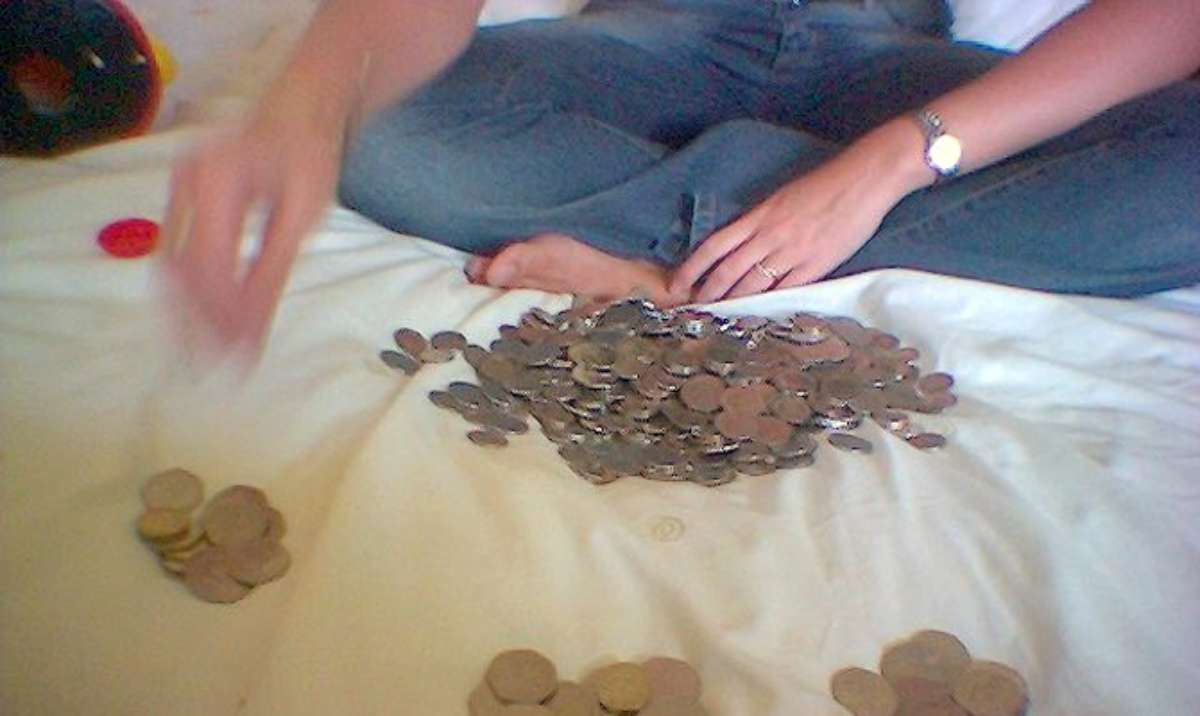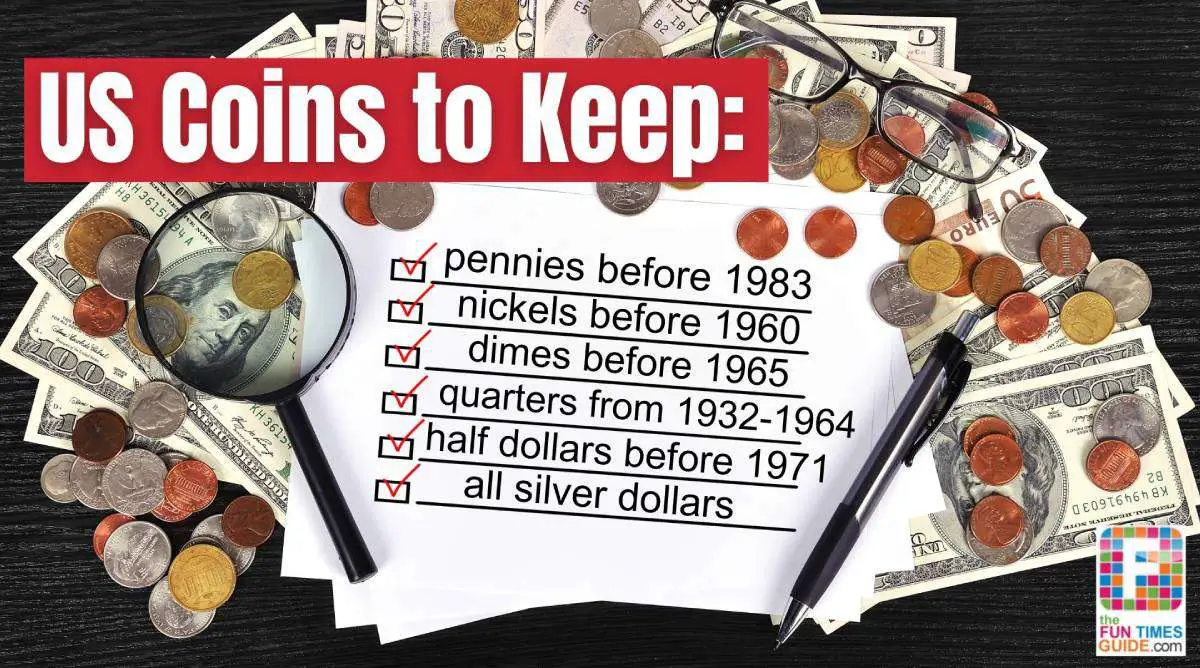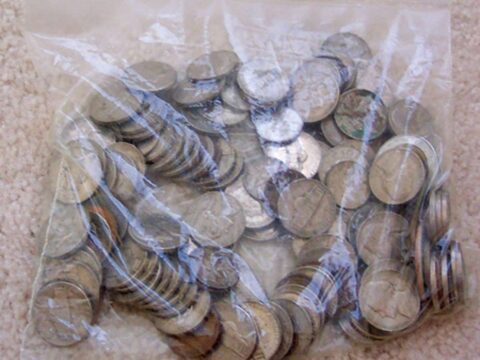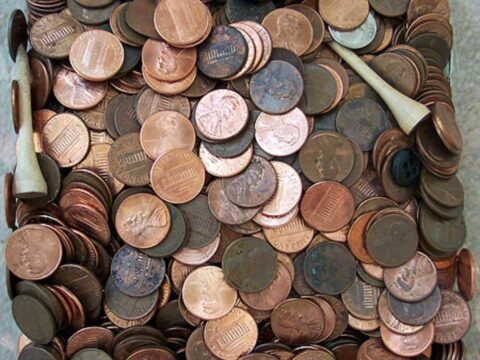Do you think you have a United States rare coin? I thought I did.
I’m not exactly a coin collector. And I’m far from a numismatist. So, for the latest coin facts and values, you’ll want to check out the articles written by our coin expert, Josh. (See how Josh came to write for us at the end of this article!)
What follows is my own novice approach to finding the value of some U.S. coins I had saved through the years (edited by Josh, since he understands coin values much better than I do).

Everyone does this at some point, right?… We set aside a good chunk of a day just to dig through saved coins to see how many valuable coins we’ve accumulated through the years.
Have you gone through the coins in your coin jar yet?
Today, I’m going to help you do just that!
In this article you will learn how to check a coin’s value yourself and what coins to look for in change:
- First, I’ll highlight the coins in my spare change jar, and what I thought I should be looking for in terms of rare coins.
- Then, I’ll show you how I found the values for all of the coins in my jar. You’ll see all of the free online coin price guides and resources that were the most helpful to me as a complete novice.
- Next, I’ll share my Best Coins To Keep “cheat sheet” with you! It’s a list that Josh and I compiled together — all the coins that you should be keeping whenever you’re looking through pocket change and coin jars. (Legit coin collectors like Josh would also add coin rolls as another great place to find valuable coins — for FREE.)
- And finally, you’ll see the total value of the coins from my coin jar.
The U.S. Coins In My Coin Jar

I was looking around for some coins for the soda machine yesterday, when I found a 1974 nickel that looked strangely silver-colored — or else strangely dirty.
I don’t know if 1974 nickels are especially valuable in terms of rare coins or not, but I do remember my Dad always telling me there are coins from certain years that you’re supposed to hold onto.
My Dad said something about…
- Pennies with wheat stalks on the back
- Coins with a “D” on them
- Any silver coins (…but how are you supposed to tell?)
- Susan B. Anthony $1 coins
Anyway, I thought I’d do a little research to find out which U.S. coins are actually worth money these days.
And from now on, I’ll be saving any coins I find that are worth more than face value!
(Again, I’m not a collector. Just a person who likes to find small treasures in life without much effort — so my coin collecting goals are simple: SHOW ME THE MONEY.)
How To Use An Online Coin Price Guide
The best sites on the web that I found provide quick access to current coin values are these:
Those sites are always up-to-date, and they make it easy to find the value of virtually any U.S. coin!
The trick comes in knowing what the grade (or condition) of your coin is — there are a bunch of different abbreviations that designate the various coin grades.
The only thing I know for sure about the grade of my coins is they are all CIRCULATED — therefore, they are all showing signs of wear. This alone pretty much makes all of the coins in my coin jar worth the lowest figures listed on the above sites.
For example, MS means “Mint State” (or uncirculated) — which mine are not.
I think the coin grades that mostly apply to circulated coins are these:
| G: | Good | A coin with considerably heavy wear. “Good” is considered the lowest grade collectible for “common” coins (any coin that is not rare or scarce). |
FR: | Fair | A coin with very severe wear. Some people will collect “fair”-quality pieces for coins which are very rare (as is the case with very early half-cents and large cents). |
| F: | Fine | A coin with heavy wear. “Fine” coins usually have full rims, and all major details are intact. |
| EX or XF: | Extremely Fine | A coin with light wear and has all basic details visible. Higher-level “EF” or “XF” coins often show light traces of luster. |
I also like how the above coin value sites thoroughly describe everything you could possibly want to know about each U.S. coin:
- The series that coin belongs (to such as “Jefferson nickels”) and the years that series ran (“1938-present”)
- How many of that coin were made
- The lowest value AND highest value for that particular coin (based on the condition of the coin)
- Some rare and valuable versions of that coin to keep an eye out for
- And lots of miscellaneous info to help you understand the coin’s history and value
A List Of Coins To Look For In Your Pocket Change
Following are the best coins to keep — it’s a “cheat sheet” of sorts that you can print out and refer to often.

Many of these are rare coins that I have personally come across myself in circulation. So, your odds of finding them in your pocket change or coin jar are quite good, too.
Yes, rare coins can actually be found in circulation today! (Here you can see what determines a coin’s rarity — and what makes a coin scarce versus rare.)
Circulated Coins To Look For:
- Lincoln pennies dated before 1983 — Pre-1983 pennies for their copper value alone… worth about 2 cents. Also, a few 1982 pennies happen to be made of copper as well!
- Wheat pennies dated before 1959 — Wheat pennies are worth 2 to 5 times their face value. That’s 2 to 5 cents… and better than just a penny! There are a few super rare wheat pennies worth a lot of money, too.
- Steel pennies from 1943 — The 1943 steel pennies are supposedly very common, but they’re worth up to 10 cents. Again… better than just a penny! (All of mine from 1943 stick to a magnet which means they are steel pennies.)
- Indian Head pennies (1959 to 1909) — Who knew a penny could be worth up to $3 dollars? It’s true… if it’s an Indian Head penny!
- Buffalo nickels (1913 to 1938) — These have the Indian on front and buffalo on back… they’re worth up to $1 dollar! In fact, some don’t even have a date… There are literally millions of dateless Buffalo nickels that exist, and they’re worth 50 cents or more.
- Nickels dated before 1960 — The 30s, 40s, and 50s are the best years for valuable nickels. Have you ever heard of war nickels from 1942 to 1945? They’re nickels made of silver and worth about $1. What about Liberty Head nickels? They’re worth $2 to $3 today!
- Dimes dated before 1965 AND dimes dated 1982 — All dimes before 1965 were made of silver, and worth about $2 apiece. There are also several thousands of 1982 dimes with no mintmark that escaped the mint and can still be found in circulation today — they’re worth $30 to $50 apiece!
- Quarters dated 1932 to 1964 AND quarters dated 1982-1983 — U.S. quarters from 1932-1964 were made of silver and are generally worth $5 to $10 apiece. Also, 1982 quarters and 1983 quarters are a little bit special and worth $1 to $3 each.
- Half dollars dated before 1971 — All half dollars made before 1971 are made of silver. They’re worth $4 to $10!
- Silver dollars (1794 to present) — Of course silver dollars. Because… well duh, they’re made of silver! The values for these coins are all across the board, but modern silver dollars are on the lower end… just over $1 to just under $20 apiece.
Again, the prices listed above are for circulated coins in worn condition — and those are the ones that most of us will have.
To see if any of the silver coins listed above have changed in value (due to the price of silver fluctuating), you can check this list of current values for U.S. silver circulated coins.
These Coins From My Jar Are Worth The Most…

Turns out, my 1974 dirty silver-looking nickel is worth a whopping… 5 cents. Yep, just face value.
But I still felt the urge to continue rummaging through all of the old coins I’ve been saving through the years. I mean, what are the odds that I could be sitting on something of value?
After a quick search here, this is what I found…
It’s not much, but the maximum value of my “rare coins” collection looks to be around $3.10.
These are the most valuable coins in my collection:
- (2) 1964
silverJefferson nickels (5x face value = $.25 ea) - (2) 1959
silverJefferson nickels (5x face value = $.25 ea) - (1) 1943 Mercury dime (10x face value = $1.00 ea)
- (22) 1939-1958 Wheat pennies (5x face value = $.05 ea)
Unless I take this guy’s advice into account…
He says that I can get around 50 cents to a dollar for each of my 1942-64 nickels! And since I have 88 of them… at 50-cents apiece, that equals: $44! Guess I’ll be holding onto those just in case. (The site claims $2 for “very fine” quality, which mine are not — so I deducted $1.50 each to account for the “well-circulated” condition of my nickels.)
These Coins From My Jar Aren’t Worth Much…

The following coins that I also had in my coin jar are just worth face value (in worn / circulated condition):
- Pennies with the Lincoln Memorial (1959-present)
- Jefferson Nickels (only the ones from 1960-present)
- Roosevelt Dimes (1965-present)
- Washington Quarters (even the bicentennial one, 1965-present)
- Susan B. Anthony Dollars (1979-1999)
Now, if you happen to have any U.S. coins that are NOT worn… (That means they’re uncirculated and show no signs of wear.) Well then, you very likely have a collection of coins that are worth a whole lot more!!!
Ah well… maybe my U.S. stamp collection is worth something. My mom will tell you it is. She’s the one who bought most of those “plate block sets of 4” for me through my elementary and high school years! At the very least, I know that I’ve got a few thousand dollars worth of “mint condition” stamps — in face value alone!

So, the bottom line is… the coins in my change jar aren’t particularly rare, but here’s a rare coins list filled articles about rare coins that you really should be looking for!
Fun Things I’ve Done With Coins
Maybe I haven’t struck it rich from my pocket change yet, but I’ve definitely had a good time scavenging around for valuable old coins through the years…

As a kid, we used to save up our pennies, and then take them down to the train tracks. We’d place a slew of them on the actual rails, then wait for a train to pass by. The trains would flatten the pennies like pancakes, turning our pennies into mini copper saucers. We’d save the flat pennies for a few years — until we decided to start skipping them (like rocks) in the river.
Then one year, my Dad had me convinced that coin collecting was yet another hobby I needed to start. (That’s in addition to my beer can collection, my matchbook collection, my rock collection, my keyring collection, and my stamp collection!)
My goal when collecting coins as a child was to save:
- 1 penny from every year
- 1 nickel from every year
- 1 dime from every year
- 1 quarter from every year
- 1 half dollar from every year
- 1 dollar coin from every year
Back then, I polished them all up nice and shiny too. (I used a pencil eraser.) Little did I know at the time that cleaning coins is a very bad thing to do. Now I’m heeding Josh’s advice… DON’T clean your coins!!!
The biggest thing I learned today is sometimes you’ve gotta look real hard to spot what makes a coin valuable — like this 1995 penny! Gosh, I never even knew to look for “weird things” on coins — like double dies and off-center designs. Rare coins like that are worth thousands of dollars!
I wonder… does all this coin research make me an amateur numismatist now???
Here is Josh’s ultimate list of error coins and mint mistakes!
How To Check A Coin’s Value
The takeaway from my coin jar experience and knowing what coins to look for is this…
If you have a coin and you would like to know what it’s worth, you have 3 good options:
- Check online coin price guides: Heritage Galleries & Auctioneers OR Professional Coin Grading Service OR Greysheet by CDN Publishing.
- Get your own coin price guide book to check current coin values yourself at home.
- Leave a comment (and a picture of your coin) on any coin article here at TheFunTimesGuide — and Josh (our coin expert) will do his best to help you out!
Just for fun, you can use this coin jar calculator to find out how much your coins are worth… or try these free online coin calculators.
UPDATE: How Josh Came To Be Our Coin Expert
Years ago, I received this comment to the above article I wrote:
Hello Lynnette, nice article. However, the 1959 and 1964 Jefferson nickels that you found in your coin collection are not silver. You may be thinking of the 1942-1945 Jefferson nickels that contained 35% silver. Really, only the copper-nickel clad Jefferson nickels dated before 1942 are valued by collectors. Most post-1945 nickels are fairly common in circulation.
— Joshua
Since Josh clearly knows a lot more about coins than I do (check out his bio), we reached out to him and asked if he would like to permanently write about coins here at The Fun Times Guide to Coins. That was way back in 2008!
To date, Josh has written over 850 coin articles on this coin site — helping new collectors and non-collectors (like me) better understand the coins they own and how much they’re worth.
If you, too, have found some neat coins in your pocket change or coin jar (or you’ve inherited a collection from a family member or an estate sale) and you want to know how much your coins are worth… just search for your specific coin using the “search box” on this page (look for the little magnifying glass). Chances are, Josh has already written an article about your coin!




